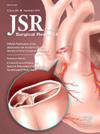全国小儿创伤性十二指肠损伤分析。
IF 1.8
3区 医学
Q2 SURGERY
引用次数: 0
摘要
导言:十二指肠外伤因其严重性、罕见性和复杂性而难以诊断和处理。本研究旨在利用全国性加权数据库分析十二指肠损伤患儿的人口统计学和临床特征:十二指肠损伤患者的临床修订代码。将这些病例与所有其他外伤住院病例进行比较:十二指肠损伤患者(n = 237)多为老年人、男性或 NAT 受害者。他们的损伤严重程度评分更高,住院时间更长。最常见的受伤机制是机动车碰撞。十二指肠损伤患者通常同时伴有肺、肝、胰腺和大肠损伤。他们更常接受开腹手术和大肠切除术,需要肠外营养,并接受更多的输血。NAT子分析表明,与非NAT十二指肠损伤相比,NAT导致的十二指肠损伤患者更年轻,更多发生在东北部,更多购买了政府保险。多变量逻辑回归显示,与女性相比,男性十二指肠损伤住院的几率更高(调整后的几率比 [aOR] 1.88;95% 置信区间 [CI] 1.31-2.67),年龄更大(aOR 1.04,95% CI 1.01-1.07),并且是 NAT 的受害者(aOR 4.18,95% CI 2.19-7.97) 结论:小儿十二指肠损伤最常见于男性患者,是机动车碰撞的结果。3 岁以下患者的十二指肠损伤应提高对 NAT 的怀疑指数。与其他所有创伤住院患者相比,这些损伤总体上较为严重,并伴有其他需要干预的重大损伤,住院时间也较长。本文章由计算机程序翻译,如有差异,请以英文原文为准。
A National Analysis of Pediatric Traumatic Duodenal Injuries
Introduction
Traumatic duodenal injuries can be difficult to diagnose and manage due to their severity, rarity, and complexity. This study aimed to analyze demographic and clinical characteristics of children with duodenal injuries using a weighted, national database.
Methods
Cases of duodenal injury in patients <18 y of age were identified in a cross-sectional analysis of the 2016 Kids’ Inpatient Database using International Classification of Diseases, 10th Revision Clinical Modification codes. These were compared to all other trauma hospitalizations age <18 y old through multivariable logistic regression to determine odds of hospitalization for duodenal injuries. Secondary analysis was performed on patients with nonaccidental trauma (NAT).
Results
Duodenal injury patients (n = 237) were frequently older, male, or victims of NAT. They had a higher injury severity score, and longer length of stay. The most common mechanism was motor vehicle collision. Patients with duodenal injuries more often had concomitant lung, liver, pancreas, and large bowel injuries. They more frequently underwent laparotomy, large bowel resection, required parenteral nutrition, and received more blood transfusions. NAT subanalysis demonstrated that as compared to non-NAT duodenal injuries, those with duodenal injuries due to NAT were younger, more often in the Northeast, and more often had government insurance. Multivariable logistic regression demonstrated increased odds of hospitalization of duodenal injury for males as compared to females (adjusted odds ratio [aOR] 1.88; 95% confidence interval [CI] 1.31-2.67), older age (aOR 1.04, 95% CI 1.01-1.07), and victims of NAT (aOR 4.18, 95% CI 2.19-7.97)
Conclusions
Pediatric duodenal injuries most commonly occur in male patients as a result of motor vehicle collisions. Duodenal injury in patients under 3 y of age should raise the index of suspicion for NAT. These injuries overall are severe, are associated with other significant injuries that require intervention, and have a longer length of stay as compared to all other trauma hospitalizations.
求助全文
通过发布文献求助,成功后即可免费获取论文全文。
去求助
来源期刊
CiteScore
3.90
自引率
4.50%
发文量
627
审稿时长
138 days
期刊介绍:
The Journal of Surgical Research: Clinical and Laboratory Investigation publishes original articles concerned with clinical and laboratory investigations relevant to surgical practice and teaching. The journal emphasizes reports of clinical investigations or fundamental research bearing directly on surgical management that will be of general interest to a broad range of surgeons and surgical researchers. The articles presented need not have been the products of surgeons or of surgical laboratories.
The Journal of Surgical Research also features review articles and special articles relating to educational, research, or social issues of interest to the academic surgical community.

 求助内容:
求助内容: 应助结果提醒方式:
应助结果提醒方式:


